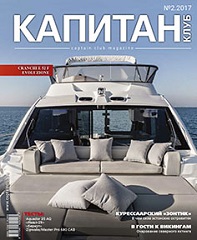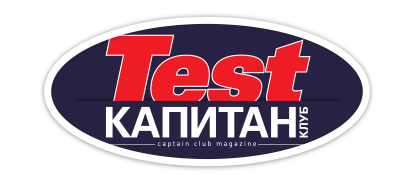| |
 All the independent sea trials, listed in this section, are performed by our staff journalists only, which have proper driving licenses, considerable boating experience and an experience of participation in powerboating and sailing competitions. All the independent sea trials, listed in this section, are performed by our staff journalists only, which have proper driving licenses, considerable boating experience and an experience of participation in powerboating and sailing competitions.
 The estimations in the test reports, printed in the magazine, could involve some subjective component, determined with a personal opinion of the respective author, though rested on the substantial comparative base (on the credit side of the magazine test-pilots is more than a thousand boats of various classes and dimensions). The estimations in the test reports, printed in the magazine, could involve some subjective component, determined with a personal opinion of the respective author, though rested on the substantial comparative base (on the credit side of the magazine test-pilots is more than a thousand boats of various classes and dimensions).
 The results of instrumental measurements of speed, fuel consumption and noise level are completely impartial and never depend on any personal opinions or favors. The results of instrumental measurements of speed, fuel consumption and noise level are completely impartial and never depend on any personal opinions or favors.
 Speed measurements are performed by GPS gauge with all satellite channels active and position accuracy no less than 10 m at two passages in opposite directions to compensate wind and current influence. For powerboats the backward passage is to be performed strictly along the GPS track of the primary passage to eliminate a possible difference in current speed on various parts of the water area (most important on rivers). For sailboats it's usually rather difficult to have a complete polar diagram in a real conditions because of inconstant wind speed and direction, so the several speed readings on the main points of sail (both port and starboard), as well as approximate close haul and drift angles are indicated. Speed measurements are performed by GPS gauge with all satellite channels active and position accuracy no less than 10 m at two passages in opposite directions to compensate wind and current influence. For powerboats the backward passage is to be performed strictly along the GPS track of the primary passage to eliminate a possible difference in current speed on various parts of the water area (most important on rivers). For sailboats it's usually rather difficult to have a complete polar diagram in a real conditions because of inconstant wind speed and direction, so the several speed readings on the main points of sail (both port and starboard), as well as approximate close haul and drift angles are indicated.
 As the magazine test-pilots very often have to do with brand new boats (at times just off a boatyard), equipped with brand new inboard or outboard engines, which have only partial break-in or no break-in at all, the figures in the technical result tables can be regarded as a proved minimum only: after further running-in the maximum speed and the range can increase, while the fuel flow can drop down. As the magazine test-pilots very often have to do with brand new boats (at times just off a boatyard), equipped with brand new inboard or outboard engines, which have only partial break-in or no break-in at all, the figures in the technical result tables can be regarded as a proved minimum only: after further running-in the maximum speed and the range can increase, while the fuel flow can drop down.
 Since the speed results could depend on a lot of various factors, the table of technical results is always supplied with a list of specific conditions – having to do with weather (wind speed, wave height, air and water temperature), as well as the technical variables (number of persons aboard, weight of a load, amount of fuel and water in tanks at the beginning of measurements). Besides, some other factors could be indicated, like the position of a canopy or bimini, which could produce additional aerodynamic drag, and the position of trim tabs or interceptors. For boats with outboard motors the main specs of propellers are indicated (material, number of blades, diameter/pitch, brand or series). Since the speed results could depend on a lot of various factors, the table of technical results is always supplied with a list of specific conditions – having to do with weather (wind speed, wave height, air and water temperature), as well as the technical variables (number of persons aboard, weight of a load, amount of fuel and water in tanks at the beginning of measurements). Besides, some other factors could be indicated, like the position of a canopy or bimini, which could produce additional aerodynamic drag, and the position of trim tabs or interceptors. For boats with outboard motors the main specs of propellers are indicated (material, number of blades, diameter/pitch, brand or series).
 The top speed of planning boats, gained on maximum rpm by optimal hull trimming, indicated for the stable mode only (for example, the results, achieved with porpoising, side swinging or yawing, uncomfortable for passengers and requiring from a driver a constant control of the boat, are not included to the table, but could be mentioned in the main text). The top speed of planning boats, gained on maximum rpm by optimal hull trimming, indicated for the stable mode only (for example, the results, achieved with porpoising, side swinging or yawing, uncomfortable for passengers and requiring from a driver a constant control of the boat, are not included to the table, but could be mentioned in the main text).
 The values of the range on a respective rpm, indicated in the table, is calculated on a base of a total hourly fuel consumption, a speed and a capacity of a standard fuel tank or tanks (without taking a non-expendable store into account, if it's not indicated separately by the boatbuilder). The values of the range on a respective rpm, indicated in the table, is calculated on a base of a total hourly fuel consumption, a speed and a capacity of a standard fuel tank or tanks (without taking a non-expendable store into account, if it's not indicated separately by the boatbuilder).
 For illustrating the test reports we use only the photo and video materials which have been taken directly during the respective sea trial (video supplements are accessible via QR-code printed in the magazine or by clicking the “camera” icon here on the web site); the rare exception could be only the interior pics, granted with a boatbuilder. For illustrating the test reports we use only the photo and video materials which have been taken directly during the respective sea trial (video supplements are accessible via QR-code printed in the magazine or by clicking the “camera” icon here on the web site); the rare exception could be only the interior pics, granted with a boatbuilder.
|
|
















